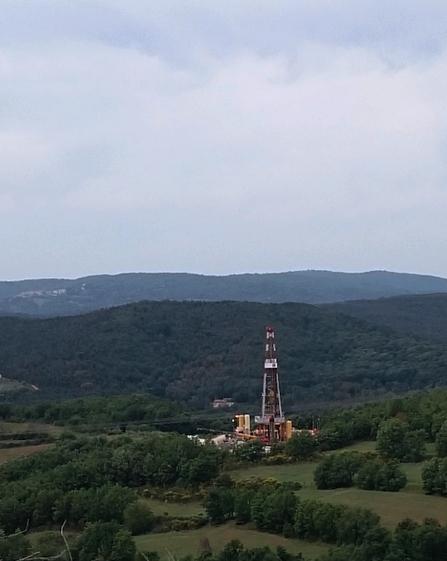Researchers from the University of Geneva have studied the seismic activity recorded during the drilling of a geothermal well and shown that it did not spark any major earthquake.

Credit: © Riccardo Minetto
Although stopping climate change is challenging, it is imperative to slow it down as soon as possible by reducing greenhouse gas emissions. But how can we meet the growing energy demand while reducing our use of polluting fossil fuels? Geothermal energy is an efficient, non-polluting solution but in certain cases geothermal operations must be handled with care. Reaching the most powerful sources of available energy means drilling deep into the layers of the earth’s crust to find geothermal fluids with high energy content (hot water and gas released by magma). Yet, the deeper we drill the greater are the subsurface unknowns controlling the stability of the Earth’s crust. Destabilising the precarious equilibrium at depth with geothermal wells may reactivate the geological layers causing earthquakes. Researchers at the University of Geneva (UNIGE), Switzerland, working in collaboration with the University of Florence and the National Research Council (CNR) in Italy, have studied the seismic activity linked to a geothermal drilling in search of supercritical fluids. They discovered that the drilling did not cause uncontrolled seismic activity. This drilling under such critical conditions suggests that the technology is on the verge of mastering geothermal energy, paving the way for new sources of non-polluting heat and electricity. You can read all about the results in the Journal of Geophysical Research.
The scientific community agrees that CO2 emissions need to drop by 45% by 2030 and that 70% of our energy must be renewable by 2050. But how can these targets be met? Geothermal power – a renewable form of energy – is part of the solution. A number of countries, including Switzerland, are already exploiting geothermal energy to produce heat from shallow wells. Until 1,500 metres such technology normally presents little risk. “To generate electricity, however, we have to drill deeper, which is both a technological and a scientific challenge”, points out Matteo Lupi, a professor in the Department of Earth Sciences in UNIGE’s Faculty of Science. In fact, drilling deeper than 1,500 metres requires special care because the unknown factors relating to the subsurface increase. “Below these depths, the stability of the drilling site is more and more difficult and poor decisions could trigger an earthquake.”
A first success at Larderello-Travale in Italy?
The Larderello geothermal field in Tuscany – the world’s oldest – currently produces 10% of the world’s total geothermal electricity supply. We know that at about 3,000 metres depth, we reach a geological layer marked by a seismic reflector, where it is thought that supercritical fluids may be found. Supercritical fluids yield an enormous amount of renewable energy. The term supercritical implies an undefined phase state – neither fluids nor gaseous – and boast a very powerful energy content. “Engineers have been trying since the 1970s to drill down to this famous level at 3,000 metres in Larderello but they still haven’t succeeded”, explains Riccardo Minetto, a researcher in UNIGE’s Department of Earth Sciences. “What’s more, we still don’t know exactly what this bed is made up of: is it a transition between molten and solid rocks? Or does it consist of cooled granites releasing fluids trapped at this level?” The technology is becoming ever more sophisticated. Because of this geothermal drilling in search of supercritical conditions has been attempted once more at Larderello-Tavale. The aim? Deepening a wellbore few centimetres wide to a depth of 3,000 metres to tap these supercritical fluids. “This drilling, which formed part of the European DESCRAMBLE project, was unique because it targeted the suggested transition between rocks in a solid and molten state”, continues professor Lupi.
The Geneva team set up eight seismic stations around the well within a radius of eight kilometres to measure the impact of the drilling on seismic activity. As the drilling progressed, the geophysicists collected the data and analysed each difficulty that was encountered. “The good news is that for the very first time, drilling in search of supercritical fluids caused only minimal seismic disturbance, which was a feat in such conditions and a strong sign of the technological progress that has been made”, explains professor Lupi. His team used the eight seismic stations to distinguish between the natural seismic activity and the very weak events caused by the drilling. The threshold of 3,000 metres, however, was not reached. “The engineers had to stop about 250 metres from this level as a result of the extremely high temperature increase – over 500 degrees. There’s still room for technical progress on this point”, says Minetto.
This study indicates that the supercritical drilling went well and that the technology is close to being mastered. “Until now, anyone who had tried to sink a well in supercritical conditions did not succeed because of the high temperatures but the results here are extremely encouraging”, says professor Lupi. Switzerland is itself very active in promoting geothermal energy. This renewable source of energy if developed further would share some of the burden of the country’s hydropower, solar and windpower. “Geothermal energy could be one of the main sources of energy of our future, so it’s only right to promote future investments to develop it further and safely”, concludes the Geneva-based researcher.
###
Media Contact
Matteo Lupi
[email protected]
41-223-796-613
Related Journal Article
http://dx.




